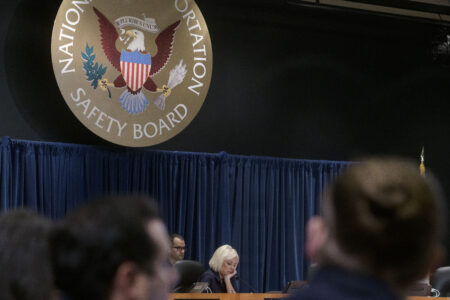Bombings shatter Baghdad ‘safe zone’
Three Americans killed in pair of suicide attacks
Baghdad, Iraq ? Insurgents carrying homemade bombs pierced Baghdad’s fortified Green Zone on Thursday, unleashing a pair of lunchtime explosions that killed at least three American civilians and shattered what was left of the perception that the Green Zone is a safe place to live and work. Two Iraqis were reported killed as well, and 20 people were wounded.
The mid-day blasts ripped through two popular hangouts in the area now officially referred to as the International Zone, which is in the heart of the Iraqi capital and is home to the U.S. Embassy and thousands of Western soldiers and civilians. They also struck a high-profile blow to U.S. efforts to impose stability in Iraq and start rebuilding the battered country.
The first explosion ripped through an open-air shopping bazaar as U.S. contractors, soldiers and Iraqis shopped for Persian rugs and DVDs. The blast dug a 4-foot-wide crater and propelled body parts to the roofs of the bazaar’s stalls.
“There was a big bang and, a minute later, fire,” said Kasim Ali Shawonne, a vendor in the bazaar whose two stalls were destroyed. “There were dead people everywhere — Iraqis, Americans, women — everyone dead.”
The dead Americans were employees of the private security firm DynCorp, a U.S. official in Washington said. Three members of the U.S. military, at least two State Department employees and an American civilian were among the wounded, officials said.
A group loyal to the Jordanian militant Abu Musab al-Zarqawi claimed responsibility for the bombings, which appeared to have been suicide attacks. Witnesses who saw the suspects before the bombings said they appeared to be Jordanian. It was unclear whether the bombers were included in the military’s death toll, which fluctuated throughout the day.
The blasts were only a fraction of widespread violence across Iraq Thursday, which also left at least 20 other Iraqis and four American soldiers dead in clashes, ambushes and bombings, officials said.
Though the number of guerrilla attacks has dropped in the past couple of weeks, death tolls from the incidents have remained high, and U.S. and Iraqi officials fear a surge in attacks with the start of Ramadan this weekend.
At the same time, U.S. forces are on the offensive, particularly in the western cities of Fallujah and Ramadi. Fallujah representatives suspended peace talks with the Iraqi interim government Thursday. Hours later, U.S. forces pounded the Sunni city with aerial bombing and artillery shelling.

U.S. soldiers carry a bag of body parts from a street market in downtown Baghdad. Two bombs were detonated Thursday in the Green Zone, killing at least six people, including three Americans.
U.S. forces have been hammering Fallujah for weeks, saying precise but punishing attacks have debilitated the leadership and disrupted the activities of al-Zarqawi’s militant group. Yet it was al-Zarqawi who claimed victory Thursday with the bold attack into the heart of the Iraqi and American power structure.
The Green Zone — as opposed to the rest of the city of Baghdad that U.S. officials refer to as the Red Zone — is bigger than most people even in Baghdad realize. The 4-square-mile compound along the Tigris River is home to about 10,000 Iraqis and a long list of government offices as well as foreign embassies, diplomats and several thousand U.S. soldiers. The area, known for its parks and trees, was a rare bit of green that Saddam Hussein enjoyed while the rest of his capital city constantly dealt with searing sun and dust.
Despite its concrete barriers, concertina wire and sandbag reinforcements, the Green Zone also is more vulnerable than most people realize, say residents and security experts. Mortar attacks are common, and insurgents have detonated several car bombs and homemade explosive devices on the zone’s outskirts. But a sizable strike so deep inside the zone is unprecedented.
The first Green Zone bomber struck at 12:40 in the Green Zone Bazaar, a line of vendor stalls hawking T-shirts, compact discs and other souvenirs. About a minute later, a blast ripped through the Green Zone Restaurant and Cafe.
The shopping bazaar bomb, placed in the middle of the four-block street fair, had a 20- to 40-pound charge, said Capt. Lennol Absher, an Army spokesman on the scene. The explosion blew out a nearby concrete wall and left a two-block charred radius from the crater, as propane gas tanks used by some of the stalls exploded in the blast, witnesses said.
The DynCorp security company employees died at the bazaar, officials said. They were visiting the Green Zone but lived outside it.
Killed were John Pinsonneault, 39, of North Branch, Minn.; Steve Osborne, 40, of Kennesaw, Ga.; and Eric Miner, 44, of South Windham, Conn. A fourth DynCorp worker, Ferdinand Ibaboa, 36, of Mesa, Ariz., was missing and presumed dead.
The second explosion shredded the Green Zone Cafe, a glorified tent next to a stone building that used to be a gas station. Strands of orange tenting were draped over twisted sheets of corrugated metal, and the scene after the bombing was littered with glass, plastic chair parts, blood, food and pieces of flesh.
The bomb left a crater in the pavement inside the restaurant about 2 feet deep and 2 feet wide. An Iraqi flag was still draped over the cashier counter.
Mohammed “Mo” Nawaf al-Obeidi, 25, who owns Mo’s Restaurant nearby, was sipping tea at the Green Zone Cafe when he heard the blast at the bazaar about five blocks away.
“I knew something else was going to happen,” said al-Obeidi, whose right hand was bandaged for a cut from flying glass.
And then the something else did happen.
“People were screaming. I was on the floor,” al-Obeidi said. “People were stampeding, trying to get out.”




